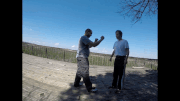The biggest thing is likely that I enjoy it more. But when I train grappling, whether throwing or ground grappling, I have a block. I'll know what to do, but my body and the 'opponents' body don't always do exactly what I want it to. Eventually, it will, and I learn, but it takes weeks for me to get something down where the equivalent in striking will take me half an hour (to a basic level, obviously). Then when it comes to variations and strategies, I can pick up both of those fairly quickly in striking-if someone tells me "no do this, instead of that", and I already know one variation or tactic, I can pick up the other rather easily. If I'm told to do the same with a variation for grappling, I have to learn the variation all the way from the beginning. And when it comes to tactics, I just can't wrap my head around them. It's not a matter of panicking when I'm grappling-if I'm allowed to strike, I can very easily figure out a way to use striking to either escape/disengage, or position myself how I need to. But if I can only grapple, it becomes immensely more difficult for me.

